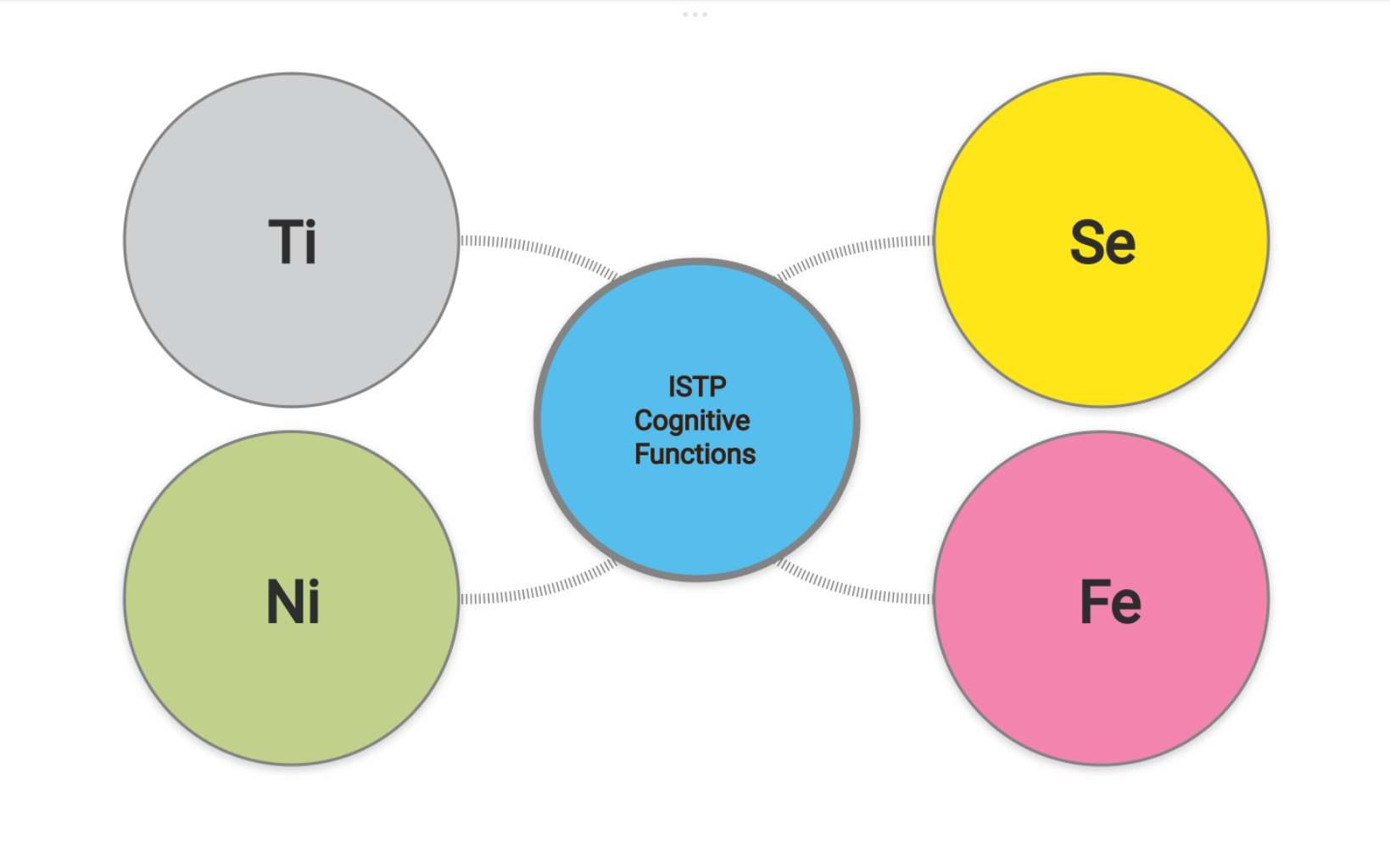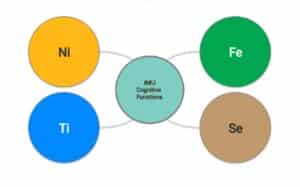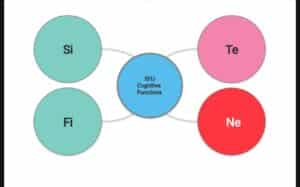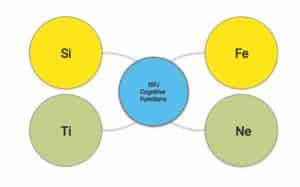Reading Time: 23 Minutes
If you’ve ever wondered what makes ISTPs tick, then you’re in the right place. Understanding ISTP cognitive functions is like peeking under the hood of a finely-tuned engine. These functions—Introverted Thinking (Ti), Extraverted Sensing (Se), Introverted Intuition (Ni), and Extraverted Feeling (Fe)—work together to shape how ISTPs think, feel, and interact with the world. Whether you’re an ISTP yourself or trying to understand one, getting a grip on these cognitive gears can help you see why ISTPs are the way they are.
The Four Cognitive Functions of ISTP
1. Dominant Function: Introverted Thinking (Ti)
Let’s start with the big boss of the ISTP mind: Introverted Thinking, or Ti for short. Ti is like that friend who’s always analyzing everything, breaking things down to see how they work. Imagine you’re staring at a clock, and instead of just seeing the time, you’re thinking about the gears inside, how they move, and why they don’t stop ticking. That’s Ti in action. For ISTPs, this function is constantly at work, figuring out how things function, making logical connections, and solving problems like a detective piecing together clues.
Now, while this might sound intense, it’s really just second nature to ISTPs. They don’t do it because they’re trying to be super smart; they just genuinely enjoy understanding the world. It’s like their brain is always tinkering with ideas, even when they’re not aware of it. If you’ve ever wondered why ISTPs seem to be so cool under pressure, it’s because Ti is always working behind the scenes, calmly figuring out the most logical solution to any problem.
2. Auxiliary Function: Extraverted Sensing (Se)
Next up is Extraverted Sensing, or Se, the action-oriented partner to Ti’s thinker. If Ti is the brain, Se is the brawn. Se is all about being in the moment, noticing everything around you, and reacting to it. It’s why ISTPs have a reputation for being so hands-on and adventurous. They don’t just think about things; they *do* them. Se drives them to experience the world directly, whether it’s through sports, fixing things, or just appreciating the beauty of the world around them.
You know how some people get bored sitting around doing nothing? That’s Se talking. For ISTPs, this function keeps them moving, exploring, and sometimes even pushing boundaries. It’s why they might be the first to jump into a new hobby or take a spontaneous road trip. While Ti is inside, Se is outside, gathering information through the senses, which then gets fed back into Ti’s logical machine.

3. Tertiary Function: Introverted Intuition (Ni)
Now, let’s talk about Introverted Intuition, or Ni. Ni is kind of like that quiet kid in the back of the class who occasionally says something so profound that everyone else stops and thinks, “Whoa, where did that come from?” For ISTPs, Ni isn’t as strong as Ti or Se, but it’s still there, lurking in the background, making connections that aren’t always obvious.
Ni helps ISTPs see patterns and think about the future, even if they don’t always realize they’re doing it. It’s that little voice in the back of their head that whispers, “Hey, maybe if we do this now, it’ll help us later.” But since Ni is a bit underdeveloped for ISTPs, they might not always trust it or know how to use it effectively. It’s like having a superpower that you don’t quite know how to control yet. Over time, though, ISTPs learn to listen to their Ni more, using it to make those leaps in logic that can lead to innovative solutions or surprising insights.
4. Inferior Function: Extraverted Feeling (Fe)
Last but certainly not least is Extraverted Feeling, or Fe. For ISTPs, Fe is like the shy kid at the party, awkwardly standing in the corner, unsure of how to join the conversation. Fe is all about connecting with others, understanding emotions, and maintaining social harmony. But because it’s the ISTP’s weakest function, it doesn’t always come naturally to them.
ISTPs might struggle with expressing their feelings or reading the emotions of others, which can sometimes make them seem a bit distant or detached. It’s not that they don’t care; it’s just that their Fe is a bit like a rusty old car—it takes a while to get it started. But here’s the thing: when ISTPs do tap into their Fe, they can be surprisingly caring and considerate. It’s just that they prefer to show their concern through actions rather than words.
Understanding Fe can be a bit tricky for ISTPs, but with time and effort, they can learn to navigate social situations more comfortably and even enjoy connecting with others on a deeper level.
You Might Like To Read: INFJ Cognitive Functions (NiFe/TiSe): All 4 Functions Explained in Very Simple Manner
The Dynamics of ISTP Cognitive Functions
1. Interaction Between Functions
Let’s imagine the ISTP’s mind as a well-oiled machine with four gears, each representing a cognitive function. Now, the way these gears work together is what gives the ISTP their unique style. Ti, the brainy gear, is always spinning, analyzing, and figuring things out. It’s the gear that says, “Hmm, let’s take this apart and see how it works.” But Ti doesn’t work alone. It teams up with Se, the action gear, which is all about doing, experiencing, and reacting to the world around them. Se is the gear that sees a tree and decides to climb it, not because it’s necessary, but because it looks fun.
Now, things get interesting when we bring Ni and Fe into the mix. Ni, the intuitive gear, quietly hums along in the background, making those subtle connections and future guesses. It’s like that moment when something just “clicks” in your mind, and you suddenly understand a complex idea. Ni gives Ti that extra push to think outside the box. Then there’s Fe, the feeling gear, which is more like a tiny cog trying to fit in. It’s not as strong or loud as the other gears, but it’s there, helping ISTPs navigate social interactions and understand others’ emotions, even if it’s not their favorite thing to do.
When these gears are in sync, the ISTP runs like a well-tuned engine. Ti and Se dominate the show, with Ni adding a touch of foresight and Fe providing a little emotional balance. But if one gear gets out of whack—say, if Se takes over and Ti can’t keep up with the thinking—things can get a bit bumpy. That’s when ISTPs might act impulsively or struggle to express their feelings. The trick is finding the right balance so that each gear does its job without overpowering the others.
2. Shadow Functions
Now, let’s dive into the shadow functions. These are like the dark, hidden gears in the ISTP machine, the ones you don’t see but definitely feel when things get rough. Shadow functions are basically the opposites of the primary functions, and they tend to show up when ISTPs are stressed, tired, or out of their comfort zone.
First, there’s Extraverted Thinking (Te), the shadow of Ti. Normally, ISTPs like to think things through quietly and methodically, but under stress, Te might kick in, causing them to act more bossy or rigid. It’s like Ti’s logical calmness flips and suddenly, ISTPs are barking orders or insisting on their way without really thinking things through.
Then we have Introverted Sensing (Si), the shadow of Se. Si is all about tradition, routine, and past experiences. When Se is in control, ISTPs are all about the here and now, but if Si pops up, they might find themselves stuck in old habits or becoming overly cautious, afraid to try something new.
Next, there’s Extraverted Intuition (Ne), the shadow of Ni. While Ni helps ISTPs see the big picture and make insightful connections, Ne can cause them to overthink and get lost in endless possibilities. It’s like Ni’s quiet certainty gets drowned out by Ne’s wild ideas, leaving ISTPs feeling scattered and uncertain.
Lastly, there’s Introverted Feeling (Fi), the shadow of Fe. Normally, ISTPs use Fe to connect with others, even if it’s not their strong suit. But under stress, Fi can cause them to become overly focused on their own feelings, leading to a sort of emotional tunnel vision where they might struggle to see others’ perspectives.
When these shadow functions take over, it’s like the ISTP machine starts running in reverse, making things feel confusing and out of control. But with awareness and a bit of self-reflection, ISTPs can recognize when these shadow gears are in play and find ways to get back on track, letting their primary functions take the lead again.
Cognitive Function Development Over the ISTP Lifespan
1. Early Development (Childhood to Adolescence)
When ISTPs are young, their cognitive functions are like seeds just starting to sprout. The first to really take root is Introverted Thinking (Ti). Picture a little ISTP kid who’s always asking “Why?” or taking apart toys to see how they work. That’s Ti in action, making its debut early on. This function loves to analyze, understand, and solve problems, even if it means breaking a few things along the way. Parents might find themselves constantly answering questions or trying to fix the gadgets their ISTP child has “improved.”
Alongside Ti, Extraverted Sensing (Se) begins to grow. Se makes young ISTPs curious about the world around them. They want to touch, explore, and experience everything firsthand. They might be the kids who climb the highest tree, build the biggest LEGO tower, or race their bikes faster than everyone else. Se isn’t just about having fun; it’s about learning through direct interaction with the world. If you ever see a young ISTP jumping into a new activity without hesitation, you’re seeing Se in action.
During these early years, Ni and Fe are like tiny sprouts that haven’t really started growing yet. Ni might show up in small bursts, like when a child suddenly connects two unrelated ideas. Fe, on the other hand, is still pretty dormant. Young ISTPs might struggle with understanding their emotions or the feelings of others, which can make social interactions a bit tricky. But that’s okay; these functions will develop more as they grow older.
2. Maturity (Adulthood)
As ISTPs move into adulthood, their cognitive functions start to blossom, especially Ti and Se. Ti becomes sharper, making ISTPs more efficient problem-solvers and logical thinkers. They’re the adults who can figure out how to fix almost anything, whether it’s a broken appliance, a tricky work problem, or even a relationship issue (though that last one might take a bit more effort). Se also continues to thrive, making ISTPs excellent at living in the moment and reacting quickly to their surroundings. They might be the ones who can stay calm in a crisis, making decisions on the fly and handling whatever life throws at them.
But adulthood isn’t just about refining the strengths you already have; it’s also about developing the ones that aren’t as natural. This is where Introverted Intuition (Ni) and Extraverted Feeling (Fe) come into play. Ni begins to develop more fully, giving ISTPs the ability to think about the future and see the bigger picture. They might start to trust their gut instincts more, using their intuition to guide their decisions. It’s like adding a new tool to their already impressive toolkit.
Fe, though still a bit rusty, also starts to get some use. ISTPs might find themselves more aware of how their actions affect others, or they might start to develop a deeper understanding of emotions—both their own and others’. They may not turn into social butterflies overnight, but they’ll likely get better at connecting with people, even if it’s in their own quiet, practical way.
3. Later Life
In later life, all of the ISTP’s cognitive functions have had time to grow and mature, much like a well-tended garden. Ti and Se are as strong as ever, but Ni and Fe have also come into their own, providing balance and depth to the ISTP’s personality. With age, ISTPs often become more reflective, using their Ni to think about the past and plan for the future. They might start to see the connections between different events in their lives, gaining wisdom from their experiences. It’s like Ti and Ni working together to create a well-rounded view of the world.
Fe, while still the most challenging function for ISTPs, becomes more comfortable with time. They might not become the most emotionally expressive people, but they’ll likely develop a quiet empathy and understanding for others. They might find themselves more willing to engage in social activities or offer support to friends and family in need. It’s like Fe has finally found its place in the ISTP’s life, adding a layer of warmth to their logical, practical nature.
In later years, ISTPs often achieve a sense of balance and peace with their cognitive functions. They’ve learned how to use each one effectively, and they know when to rely on their strengths and when to push themselves to grow. It’s like they’ve spent their whole lives tending to their cognitive garden, and now they can sit back and enjoy the fruits of their labor.
Practical Applications of Understanding ISTP Cognitive Functions
1. Career and Work
Understanding their cognitive functions can help ISTPs find the right career path and excel in the workplace. With Ti leading the charge, ISTPs thrive in jobs that require problem-solving, logical analysis, and independent thinking. Think of roles like engineers, mechanics, or IT specialists—these are the kinds of jobs where ISTPs can roll up their sleeves and get to the nitty-gritty details. They don’t just want to follow instructions; they want to understand why things work the way they do, and then make them work even better.
Se also plays a big role in ISTPs’ career choices. They enjoy hands-on work where they can directly interact with their environment. Jobs that involve physical activity, quick thinking, or even a bit of adventure can be a great fit. For example, they might excel as firefighters, pilots, or outdoor guides—roles that require them to stay sharp and react quickly to what’s happening around them.
However, understanding Fe can also help ISTPs navigate the social side of work. While they might not naturally gravitate towards leadership or team-oriented roles, learning to use their Fe can make them more effective in group settings. They might not be the loudest voice in the room, but when they do speak up, it’s often with a well-thought-out solution that others appreciate. And as they develop their Fe, they might find they’re better at reading the room and understanding what their colleagues need, which can make them a more valuable team member.
2. Relationships and Social Interactions
In relationships, understanding their cognitive functions can help ISTPs connect with others in a meaningful way. Ti can sometimes make ISTPs seem a bit distant or overly analytical, especially in emotional situations. They might approach a partner’s feelings like they’re solving a math problem, which isn’t always the best strategy. But by understanding how their Ti works, they can learn to balance it with a bit of Fe, showing their care through actions rather than just logic.
Se makes ISTPs fun and spontaneous partners. They’re often up for anything, whether it’s a last-minute road trip or trying out a new hobby together. This makes them exciting to be around, as they’re always looking for new experiences to share with their loved ones. But they might need to be mindful of their Ni, which helps them think about the long-term implications of their actions. While Se loves the thrill of the moment, Ni can remind them to consider how their choices might affect their relationships down the road.
By working on their Fe, ISTPs can also improve their communication skills. They might never be the most emotionally expressive people, but they can learn to listen more actively and show empathy in their own way. This might mean offering practical help when a friend is in need or quietly supporting a partner during tough times. Understanding how their Fe functions can make ISTPs more attuned to the feelings of those around them, helping them build stronger, more fulfilling relationships.
3. Personal Growth and Self-Improvement
For personal growth, understanding their cognitive functions gives ISTPs a roadmap to becoming the best version of themselves. They can start by embracing their Ti and Se strengths, finding activities and hobbies that challenge their minds and bodies. Whether it’s mastering a new skill, solving complex problems, or engaging in outdoor sports, ISTPs thrive when they’re using their natural talents.
At the same time, working on their Ni and Fe can help ISTPs grow in areas that might not come as naturally. Developing Ni could involve setting long-term goals, reflecting on their past experiences, or simply taking a bit more time to consider the future before making decisions. For Fe, ISTPs might practice expressing their feelings more openly or learning to pick up on the emotional cues of others. It’s not about changing who they are but rather adding more tools to their personal toolbox.
Common Misconceptions About ISTP Cognitive Functions
1. Debunking Stereotypes
There are quite a few misconceptions about ISTPs that can lead to misunderstandings. One of the biggest myths is that ISTPs are cold, emotionless robots. People see their logical Ti and think they’re all about numbers and facts, with no room for feelings. But that’s not really the case. ISTPs do have emotions; they just express them differently. Instead of talking about how they feel, they might show their care through actions—like fixing something for you or helping you solve a problem. It’s like their way of saying, “I care about you,” without having to get all mushy about it.
Another stereotype is that ISTPs are reckless or impulsive because of their strong Se. Sure, they love a good adventure and might jump into new experiences without overthinking them. But they’re not just thrill-seekers; they’re calculated risk-takers. Their Ti is always working in the background, analyzing the situation and figuring out the best approach. So, while they might seem spontaneous, there’s often a solid plan behind their actions, even if it’s not immediately obvious to others.
2. Differences Between ISTPs and Similar Types
It’s also important to clear up some confusion between ISTPs and similar personality types, like ESTPs or ISTJs. People often mix them up because they share some common traits, but their cognitive functions are quite different. For instance, ESTPs might seem similar to ISTPs because they both love action and hands-on activities, thanks to their shared Se function. But ESTPs lead with Extraverted Thinking (Te), which makes them more decisive and focused on external efficiency. ISTPs, on the other hand, prioritize internal logic and are more interested in understanding how things work from the inside out.
Then there’s the ISTJ, who shares Ti and Introverted Sensing (Si) with the ISTP. While both types are detail-oriented and practical, ISTJs are more focused on tradition, structure, and routines, thanks to their dominant Si. ISTPs, however, prefer flexibility and are less concerned with following established norms. They’re more likely to innovate or try new approaches, rather than sticking to the tried-and-true methods that ISTJs might favor.
Conclusion On ISTP Cognitive Functions
In a nutshell, ISTP cognitive functions are the building blocks of their unique personality. By understanding how these functions develop and interact, you can better appreciate the ISTP’s blend of logic, spontaneity, and subtle intuition. Whether it’s in their careers, relationships, or personal growth, knowing how these functions work can help ISTPs play to their strengths while also growing in areas that might not come naturally. And if you’re not an ISTP, well, now you’ve got a little more insight into what makes them such intriguing individuals.
If you like the post, then please don’t forget to share with your friends.
Some Of The Previous Posts



